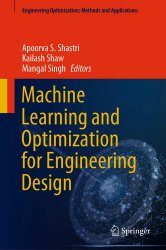Machine Learning and Optimization for Engineering Design
- Добавил: literator
- Дата: 28-12-2023, 21:10
- Комментариев: 0
 Название: Machine Learning and Optimization for Engineering Design
Название: Machine Learning and Optimization for Engineering DesignАвтор: Apoorva S. Shastri, Kailash Shaw, Mangal Singh
Издательство: Springer
Год: 2023
Страниц: 175
Язык: английский
Формат: pdf (true), epub
Размер: 35.5 MB
This book aims to provide a collection of state-of-the-art scientific and technical research papers related to Machine Learning-based algorithms in the field of optimization and engineering design. The theoretical and practical development for numerous engineering applications such as smart homes, ICT-based irrigation systems, academic success prediction, future agro-industry for crop production, disease classification in plants, dental problems and solutions, loan eligibility processing, etc., and their implementation with several case studies and literature reviews are included as self-contained chapters. Additionally, the book intends to highlight the importance of study and effectiveness in addressing the time and space complexity of problems and enhancing accuracy, analysis, and validations for different practical applications by acknowledging the state-of-the-art literature survey. The book targets a larger audience by exploring multidisciplinary research directions such as computer vision, Machine Learning, Artificial Intelligence, modified/newly developed Machine Learning algorithms, etc., to enhance engineering design applications for society. State-of-the-art research work with illustrations and exercises along with pseudo-code has been provided here.
There are several deterministic and approximation-based optimization methods that have been developed by the researchers, such as branch-and-bound techniques, simplex methods, approximation and Artificial Intelligence-based methods such as evolutionary methods, Swarm-based methods, physics-based methods, socio-inspired methods, etc. The associated examples are Genetic Algorithms, Differential Evolution, Ant Colony Optimization, Particle Swarm Optimization, Artificial Bee Colony, Grey Wolf Optimizer, Political Optimizer, Cohort Intelligence, League Championship Algorithm, etc. These techniques have certain advantages and limitations and their performance significantly varies when dealing with a certain class of problems including continuous, discrete, and combinatorial domains, hard and soft constrained problems, problems with static and dynamic in nature, optimal control, and different types of linear and nonlinear problems, etc.
Machine Learning (ML) is the most rapidly evolving technology for problem solving in engineering. It helps intelligence systems learn each typical pattern of the environment by creating submodules from historical data that take predictions or cluster models for new inputs. ML models are widely used in engineering applications to solve complex problems that existing technology cannot handle. Although LightGBM performs faster than XGBoost, more research found XGBoost base machine learning model performed best in prediction, classification and forecasting models. For feature handling, an evolutionary algorithm is used in a neural network. The prediction model is used for both regression and classification engineering applications. Anomaly detection is used to detect undesired work during running of any machine component. Time series models are used for forecasting model. This article demonstrates how a Machine Learning model improves the performance of engineering applications in thermal engineering, energy, and electrical appliances.
In the paper "OpenCV and MQTT Based Intelligent Management System", a system is proposed which is intelligent and can perform identification, counting, and calculation of density of vehicles. After calculating the traffic density, the system classifies the density into low, medium, and high density with the help of a decision algorithm. This system is based on Python programming, and the libraries used in Python are Open-source Computer Vision, NumPy, Chardet, and time library. The system is implemented in IoT-based platform Message Queuing Telemetry Transport. The system methodology is carried out in four phases. The first is vehicle detection and counting. In the second phase, the number plate of the vehicle is detected as well as displayed. The third phase includes traffic density detection and finding out the emergency vehicle based on GPS Tracking using ESP32 and IoT over MQTT. Last phase is related to pollution monitoring. This complete model for the system is made, and the results are shown in the paper.
Blockchain technology is a decentralized system for transaction validation that is safe, verifiable, and relevant to a number of sectors, including finance, the Internet of Things, Big Data, cloud computing, and edge computing. Combining blockchain, AI, ML, and IoT has the obvious benefit of granting AI greater autonomy and legitimacy. This survey report presents a thorough and three-dimensional analysis of the integration of blockchain with Artificial Intelligence (AI), Machine Learning (ML), and the Internet of Things (IoT) describing potential benefits and challenges. It looks at the current problems and challenges in the field as well as prospective directions for future study into how to combine blockchain with AI, ML, and IoT.
Скачать Machine Learning and Optimization for Engineering Design
Внимание
Уважаемый посетитель, Вы зашли на сайт как незарегистрированный пользователь.
Мы рекомендуем Вам зарегистрироваться либо войти на сайт под своим именем.
Уважаемый посетитель, Вы зашли на сайт как незарегистрированный пользователь.
Мы рекомендуем Вам зарегистрироваться либо войти на сайт под своим именем.
Информация
Посетители, находящиеся в группе Гости, не могут оставлять комментарии к данной публикации.
Посетители, находящиеся в группе Гости, не могут оставлять комментарии к данной публикации.
